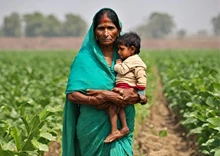
Before, most of the land in Kashmir was used for cultivating a single crop, paddy in most areas, but farmers are now alternating crops in the Kharif and Rabi seasons, just like the rest of the country. J&K UT has a wide range of climatic conditions.
"In order to achieve the Prime Minister's target of doubling farmers' income, we conducted an activity to extend the area under mustard cultivation during the Rabi season," said Chaudhary Mohammad Iqbal, Director, Agricultural Kashmir.
The agriculture department has roughly fivefold increased the area under mustard cultivation in the valley from 30,000 hectares in 2020-21. "The mustard cultivation area in 2020-2021 was only 30,000 hectares. We established and achieved a target of putting 1.01 lakh hectares of land under mustard cultivation in 2021-2022...we have brought 1.40 lakh hectares of land under mustard cultivation in the current year 2022-2023," the source added.
According to Chaudhary, the success of mustard farming can be measured by the fact that the area under cultivation of oilseed crops was greater than the area under cultivation of rice. "We have 1.25 lakh hectares of rice farming, and mustard has already surpassed that. Except for waterlogged grounds, we are attempting to cultivate as much land as possible with mustard," he stated.
He stated that because oil is a mainstay in the Kashmiri cuisine, the Valley was previously reliant on imports to meet demand. There is currently a yellow revolution in Kashmir. We hope to cover all of the areas that were not covered this year next year. One of the farmers who joined the yellow revolution, Mohammad Sultan, did not expect such unexpected benefits from mustard production.
"Before mustard cultivation, my land was used for livestock grazing, which didn't benefit us at all. We began mustard cultivation two to three years ago with the assistance of the agriculture department. We had no idea the results would be that fantastic," Sultan remarked. Several portions of the valley's terrain have turned yellow due to mustard agricultural farms.
"At the moment, mustard blooms cover the fields. We are content. The first advantage for farmers is that they may obtain oil from their own crops rather than purchasing it from the market, which is so expensive. Formerly, 30 to 40 kg of oil was gathered from one kanal of land, but now, with the department's direction, we are obtaining 50 to 60 kg in one kanal," he added.
The 70-year-old farmer has been farming for the previous 50 years, but this is his first big crop. Wali Muhammad, another farmer in the UT, agrees, saying he is glad he converted to mustard farming instead of planting grass for animal grazing. After 12 years, I grow mustard seeds again, which yield 100 times more than grass.











